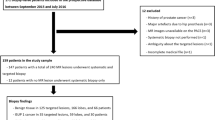Abstract
Background
We evaluated pathological findings in targeted biopsies of PI-RADS4 and PI-RADS5 lesions, and clinical data that could predict those patients with benign findings.
Materials and Methods
A retrospective study was conducted to summarize the experience from a single nonacademic center using cognitive fusion and a 1.5 or 3.0 Tesla scanner.
Results
We found a false positive rate of 29 and 3.7% for any cancer in PI-RADS 4 and 5 lesions, respectively. Diverse histologic patterns were observed among target biopsies. At multivariate analysis, size ≤ 6 mm and previous negative biopsy were independent predictors of false positive PI-RADS4 lesions. The small number of false PI-RADS5 lesions precluded further analyses.
Conclusion
Benign findings are common in PI-RADS4 lesions and most of them do not show obvious glandular or stromal hypercellularity as expected in hyperplastic nodules. Size ≤ 6 mm and previous negative biopsy predict a higher probability of false positive results in patients with PI-RADS 4 lesions.
Similar content being viewed by others
Data availability
Raw data were generated at IMAGEPAT Laboratory. Derived data supporting the findings of this study are available from the corresponding author [DAA] on request.
References
Ahmed HU, El-Shater Bosaily A, Brown LC, Gabe R, Kaplan R et al (2017) PROMIS study group. Diagnostic accuracy of multi-parametric MRI and TRUS biopsy in prostate cancer (PROMIS): a paired validating confirmatory study. Lancet 389:815–822. https://doi.org/10.1016/S0140-6736(16)32401-1
Kasivisvanathan V, Rannikko AS, Borghi M, Panebianco V, Mynderse LA, Vaarala MH (2018) PRECISION study group collaborators. mri-targeted or standard biopsy for prostate-cancer diagnosis. N Engl J Med 378:1767–1777. https://doi.org/10.1056/NEJMoa1801993
Ahdoot M, Wilbur AR, Reese SE, Lebastchi AH, Mehralivand S, Gomella PT et al (2020) MRI-targeted, systematic, and combined biopsy for prostate cancer diagnosis. N Engl J Med 382:917–928. https://doi.org/10.1056/NEJMoa1910038
Stolk TT, de Jong IJ, Kwee TC, Luiting HB, Mahesh SVK, Doornweerd BHJ et al (2019) False positives in PIRADS (V2) 3, 4, and 5 lesions: relationship with reader experience and zonal location. Abdom Radiol (NY) 44:1044–1051. https://doi.org/10.1007/s00261-019-01919-2
Rouvière O, Puech P, Renard-Penna R, Claudon M, Roy C, Mège-Lechevallier F,: MRI-FIRST Investigators, et al (2019) Use of prostate systematic and targeted biopsy on the basis of multiparametric MRI in biopsy-naive patients (MRI-FIRST): a prospective, multicentre, paired diagnostic study. Lancet Oncol 20:100–109. https://doi.org/10.1016/S1470-2045(18)30569-2
van der Leest M, Cornel E, Israël B, Hendriks R, Padhani AR, Hoogenboom M et al (2019) Head-to-head comparison of transrectal ultrasound-guided prostate biopsy versus multiparametric prostate resonance imaging with subsequent magnetic resonance-guided biopsy in biopsy-naïve men with elevated prostate-specific antigen: a large prospective multicenter clinical study. Eur Urol 75:570–578. https://doi.org/10.1016/j.eururo.2018.11.023
Barentsz JO, Richenberg J, Clements R, Choyke P, Verma S, Villeirs G, Rouviere O et al (2012) European society of urogenital radiology. ESUR prostate MR guidelines 2012. Eur Radiol 22:746–757. https://doi.org/10.1007/s00330-011-2377-y
American College of Radiology: PI-RADS v2 (2015) available at. https://www.acr.org/Quality-Safety/Resources/PIRADS2015
Robinson BD, Epstein JI (2010) Intraductal carcinoma of the prostate without invasive carcinoma on needle biopsy: emphasis on radical prostatectomy findings. J Urol 184:1328–1333. https://doi.org/10.1016/j.juro.2010.06.017
Gordetsky JB, Ullman D, Schultz L, Porter KK, DelPenaRodriguez M, Calderone CE et al (2019) Histologic findings associated with false-positive multiparametric magnetic resonance imaging performed for prostate cancer detection. Hum Pathol 83:159–165
Hupe MC, Offermann A, Tharun L, Fürschke A, Frydrychowicz A, Garstka N et al (2020) Histomorphological analysis of false positive PI-RADS 4 and 5 lesions. Urol Oncol 38:636.e7-636.e12. https://doi.org/10.1016/j.urolonc.2020.01.017
Sheridan AD, Nath SK, Aneja S, Syed JS, Pahade J, Mathur M et al (2018) MRI-ultrasound fusion targeted biopsy of prostate imaging reporting and data system version 2 category 5 lesions found false-positive at multiparametric prostate MRI. AJR Am J Roentgenol 210:W218-225. https://doi.org/10.2214/AJR.17.18680
Yamanaka R, Sekino Y, Babasaki T, Kobatake K, Kitano H, Ikeda K et al (2022) Histopathological analysis of false-positive lesions in mpMRI/TRUS fusion prostate biopsy. In Vivo 36:496–500. https://doi.org/10.21873/invivo.12730
van Luijtelaar A, Bomers J, Futterer J (2019) A comparison of magnetic resonance imaging techniques used to secure biopsies in prostate cancer patients. Expert Rev Anticancer Ther 19:705–716. https://doi.org/10.1080/14737140.2019.1641086
Author information
Authors and Affiliations
Corresponding author
Additional information
Publisher's Note
Springer Nature remains neutral with regard to jurisdictional claims in published maps and institutional affiliations.
Rights and permissions
Springer Nature or its licensor (e.g. a society or other partner) holds exclusive rights to this article under a publishing agreement with the author(s) or other rightsholder(s); author self-archiving of the accepted manuscript version of this article is solely governed by the terms of such publishing agreement and applicable law.
About this article
Cite this article
de Souza, B.C.A., Novaes, M.A.S., de Souza, M.F. et al. Analysis of false positive PI-RADS 4 lesions: experience from a single nonacademic center using cognitive fusion. Int Urol Nephrol 55, 1081–1085 (2023). https://doi.org/10.1007/s11255-023-03508-1
Received:
Accepted:
Published:
Issue Date:
DOI: https://doi.org/10.1007/s11255-023-03508-1




